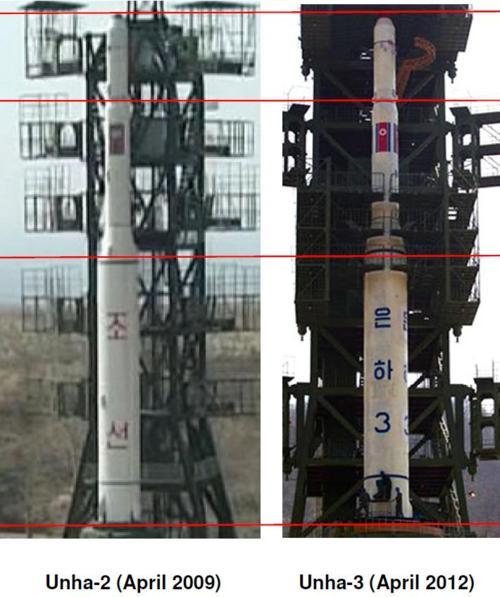Photos released today after reporters visited the North Korean launch site confirm that the Unha-3 launcher currently on the pad is very similar to the Unha-2 that North Korea launched in April 2009 (see Figure 1). The first two stages of the Unha-2 launch seemed to work as expected but the third stage did not ignite.

Figure 1: Images from AFP (left) and AP (right).
The viewing angle of the two photos is somewhat different, but despite that they show that the stages of the two rockets appear to be the same length and diameter. I expected this would be the case since I assumed North Korea would continue to work with the technology it demonstrated in 2009.
By computer modeling, I find that an Unha-3 that is a slightly modified Unha-2 is compatible with the announced locations of the splashdown zones for the first two stages, which differ significantly from the zones announced for the 2009 launch of the Unha-2. Here’s why:
When North Korea launched eastward in 2009, its rocket gained speed due to the rotation of earth. This extra speed is 0.35 km/s at the latitude of North Korea, compared to the required burnout speed of about 7.8 km/s to place a satellite in orbit at about 500 km altitude (which Pyongyang announced as the planned orbital altitude). Since North Korea will instead launch in a southern direction this time, it does not get that boost from the earth’s rotation and needs to get more speed out of the launcher to place the satellite in a 500-km orbit.
A natural way to do that would be to increase the amount of fuel in the third stage so that it can accelerate to a higher speed. Our previous modeling of the Unha-2 launch led us to believe that the third stage was not carrying as much fuel as it could, in which case increasing the fuel amount would not require changing the size of that stage.
Adding that extra mass to the upper stage would decrease the speeds at burnout of the first two stages since they have to lift more mass. These two stages would therefore be expected to splashdown somewhat closer to the launch site.
And in fact I find the numbers work out (see Figure 2). I started with my computer model of the Unha-2 (red curves below), which is based on the technology and known trajectory parameters for the 2009 launch. In particular, my model can place a satellite into orbit at an altitude of about 500 km, and the stages fall to earth at the locations reported for the 2009 launch (dotted lines). The solid red bars along the horizontal axis show the size of the 2009 splashdown zones that North Korea announced prior to that launch.

Figure 2. A comparison of computer modeling of the Unha-2 launch from 2009 (red) and a potential Unha-3 launch (blue) that carries more fuel in its third stage. The solid lines show the launcher’s trajectory; in both cases the launcher burns out and releases the satellite at range of about 2,100 km and an altitude of about 500 km. The dotted lines show the trajectories of the empty stages when they are dropped from the rocket and fall to earth. The announced splashdown zones for the two cases are shown by the solid bars just below the horizontal axis.
I then modeled the Unha-3 by keeping the first two stages the same as those for the Unha-2, and increasing the fuel in the upper stage as well as its burntime. (For my model, I increased the fuel mass in the third stage by 1-2 tons and the burntime by 50 seconds.) To place the satellite in a 500-kilometer orbit, I then had to have the launcher fly on a somewhat steeper trajectory, as shown by the solid blue line in Figure 2. What I found was that this configuration could lift the satellite to about 500 km—the altitude North Korea announced—and give it the additional speed it needs to stay in orbit. At the same time the stages fall in the new splashdown zones (shown by the blue bars under the horizontal axis).
There may be other ways to get the splashdown zones, etc., to work, but this may be the simplest.
It’s worth pointing out that I expect this trajectory to differ in two ways from that of a typical ballistic missile test. First, the launcher will fly on a steeper trajectory than would a ballistic missile on an optimum trajectory. Second, the burntime will be considerably longer than you would expect for a ballistic missile, since the launcher needs a long third-stage burntime to get the satellite to high altitude with high speed. The launch will still teach North Korea about rocket technology it could use in a missile, but it should be clear from the trajectory whether this was actually an attempt to launch a satellite.
Note added 4/9: From a better photo of the third stage, it appears that this stage is longer by 0.3-0.4 m that the upper stage on the Unha-2 in 2009, which is consistent with the idea that North Korea has increased the amount propellant in this stage for this launch.
Previous post on North Korea. Next post.
